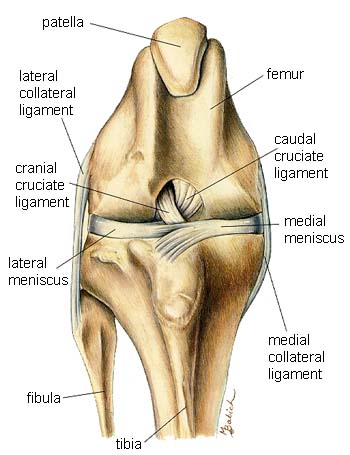When faced with a life-altering diagnosis, whether it will affect our dog temporarily or for the rest of their lives, we tend to look for ways out.
"Maybe it is something else, something that will go away on its own."
I was in the same boat when the vet told us that he suspected an ACL injury as a reason for Jasmine's limp. I too really wanted a different diagnosis.
So I truly felt for a friend of mine, asking whether there is such a thing as a false positive drawer sign.
Unfortunately, the short answer to that question is no.
What is a drawer sign?
A drawer sign, or drawer test, is a diagnostic test to determine ligament injury in a dog's knee. It is a physical evaluation of stability of the knee joint.
If there is any abnormal movement in the joint, the test is positive.
If you take a quick look at a dog's knee anatomy, you can see that the joint parts are not nested within each other, such as in the hip joint for example, but one part is pretty much sitting on top of the other. Joint stability is achieved by ligaments.
The two ligaments crucial to the knee stability are the anterior/cranial cruciate ligament ACL/CCL and the posterior cruciate ligament.
One is holding the joint parts in place front-to-back and the other back-to-front. It is the ACL/CCL ligament that is commonly injured in dogs.
If the ligament gets damaged or torn, the joint is no longer stable.
If the knee can be manipulated this way, it is a definite positive; there is no way around it.
False negative drawer sign is much more likely. In fact, that's what had me cling to hope in Jasmine's case. The vet could not make her knee joint move in any abnormal way but further diagnostics confirmed that the ligament indeed was damaged.
Many dogs need to be sedated before the presence of the drawer sign can be ruled out.
Related articles:
How The Oddysey Started: Jasmine's ACL Injury
Talk To Me About ACL Injuries
ACL Injuries in Dogs: Non-Surgical Alternatives?
ACL Injuries in Dogs and Stem Cell Regenerative Therapy
Newest Surgery For Ruptured ACL In Dogs
Preventing ACL Injuries In Dogs
ACL Injuries In Dogs: Xena's Story
ACL Injury Conservative Management: Sandy's Story
Surviving The Post-Op: After Your Dog's ACL Surgery
Talk to Me About Arthritis
Don't Forget the Physical Therapy
My Love Is Sleeping At My Feet: ACL Surgery Complications
Coco's TPLO Post-Op Diary
Small Breeds Can Hurt Their ACL Too: Star's Naughty Knee
One Thing Leads To Another: Why The Second ACL Often Goes Too
"Maybe it is something else, something that will go away on its own."
I was in the same boat when the vet told us that he suspected an ACL injury as a reason for Jasmine's limp. I too really wanted a different diagnosis.
So I truly felt for a friend of mine, asking whether there is such a thing as a false positive drawer sign.
Unfortunately, the short answer to that question is no.
What is a drawer sign?
A drawer sign, or drawer test, is a diagnostic test to determine ligament injury in a dog's knee. It is a physical evaluation of stability of the knee joint.
If there is any abnormal movement in the joint, the test is positive.
 |
| Image from Dog Health Handbook |
The two ligaments crucial to the knee stability are the anterior/cranial cruciate ligament ACL/CCL and the posterior cruciate ligament.
One is holding the joint parts in place front-to-back and the other back-to-front. It is the ACL/CCL ligament that is commonly injured in dogs.
If the ligament gets damaged or torn, the joint is no longer stable.
During the drawer test the veterinarian with stabilize your dog’s femur (thigh bone) with one hand while manipulating the tibia (shin bone) with the other. If the tibia moves forward, known as a positive drawer because of the way the bone moves similar to a drawer being opened, the ligament is ruptured.
(Source: DogKneeInjury.com)
If the knee can be manipulated this way, it is a definite positive; there is no way around it.
False negative drawer sign is much more likely. In fact, that's what had me cling to hope in Jasmine's case. The vet could not make her knee joint move in any abnormal way but further diagnostics confirmed that the ligament indeed was damaged.
The inability to elicit the drawer sign, unfortunately, does not mean the ligament is not damaged.
Many dogs need to be sedated before the presence of the drawer sign can be ruled out.
Related articles:
How The Oddysey Started: Jasmine's ACL Injury
Talk To Me About ACL Injuries
ACL Injuries in Dogs: Non-Surgical Alternatives?
ACL Injuries in Dogs and Stem Cell Regenerative Therapy
Newest Surgery For Ruptured ACL In Dogs
Preventing ACL Injuries In Dogs
ACL Injuries In Dogs: Xena's Story
ACL Injury Conservative Management: Sandy's Story
Surviving The Post-Op: After Your Dog's ACL Surgery
Talk to Me About Arthritis
Don't Forget the Physical Therapy
My Love Is Sleeping At My Feet: ACL Surgery Complications
Coco's TPLO Post-Op Diary
Small Breeds Can Hurt Their ACL Too: Star's Naughty Knee
One Thing Leads To Another: Why The Second ACL Often Goes Too
Absolutely Jana. Plus as joints become more chronic and arthritic, there is usually no drawer sign anyway. Looking for signs of arthritis is often the only indication of CCL disease.
ReplyDeleteI need help finding funding and will not give up for my cavalier. he is only 15 months and i can not afford anything right now after the hurricane etc. and other issues. i believe its CCL where can i go? i have tried mostly everything.
ReplyDeleteIt is possible that it could be the CCL, though I wouldn't see it overly likely at her age. However, first you need a precise diagnosis.
DeleteSend me an email and let's take a look what can be done.